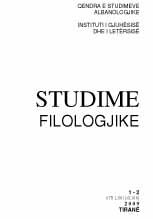Vendi i së folmes së Himarës në dialektin jugor të shqipes
The place of Himara speech in southern dialect of albanian language
Author(s): Rami Memushaj, Helena GrilloSubject(s): Language and Literature Studies
Published by: Qendra e Studimeve Albanologjike
Keywords: Himara ; speech in southern dialect of albanian language; albanian language; Albania
Summary/Abstract: In order to decide the ethnic origin of a given community, language may be used as an important element. Comparing the speech of a given community with the speech of its neighbouring communities makes it possible to answer the above question. If the majority of linguistic features of a territorial variant is found in other neighbouring variants, than this is a proof that these communities are of the same ethnic origin. This is the path we have traced in our article to determine the ethnicity of the Himara municipality, which comprises the Himara town and Palassa, Dhermi, Vuno, Ilias, Pilur, Kudhes and Qeparo villages. The Himara town, Dhermi and Palassa villages are bilingual in Greek and Albanian, while the other villages are monolingual, but either in bilingual villages Albanian is the mother tongue of their speakers. The Albanian linguists in general have agreed that the Himara speech is part of the Southern Tosk dialect and more precisely in its main subgroup, in the Lab subdialect”. Since until now nobody has undertaken a study of this speech, the authors undertook the burden to describe the phonetic, morphologic, syntactic and lexical systems of this speech. Phonetically, the Himara speech is more similar with the speech of Argirocastra and of Ciamuria, first because of its inventory of six vowels; other phonetic features are found also in some of neighbouring speeches or in Southern Tosk. In its morphological system, the Himara speech preserves some old features found only in peripheric Southern subdialects, such as Ciamurishte and Arberesh of Albanian diaspora of Italy and Greece. Such features are the neutral gender of mass nouns as qumështit, djathët, vajt(ë), ujt(ë), mishtë etj.; the feminine gender of nouns litare, djepe, turpje, vërri, etc. that in other Lab spokens and in Tosk are of masculine gender; the old objective case of masculine nouns djalë, lumë, etc.: djalën, kalën, lumën, ballën, fshatnë, gardhnë, malnë, ftuan, etc.; the definite suffix -t in the forms of the plural genitive (lisavet, kalavet, malevet, etc.); the absence of the epenthetic sound -vin nouns ending in a consonant (miqet, pleqet, krushqet, etc.); the high frequence of the suffix -ra (pambukëra, plëhëra, drëra, detra, folera, etc.); the plural suffix -j in place of -nj: qirij, ullij, bij, kallij, etc.; the plural ending -ërë (kunetërë, meçërë, çamërë, etc.); the suffix -jë (dekëjë, humbëjë, ngrënëjë, sëmundëjë, etc.), which is only a step away from the suffix -lë of the old Albanian; the derivative suffix -ejë where other dialects have -esë: ngarkejë, shtrejë, etc.
Journal: Studime Filologjike
- Issue Year: 2009
- Issue No: 01-02
- Page Range: 029-062
- Page Count: 34
- Language: Albanian

